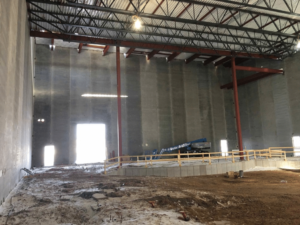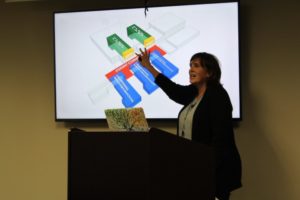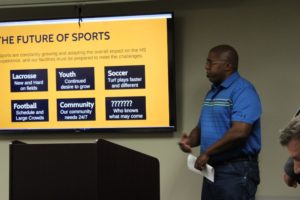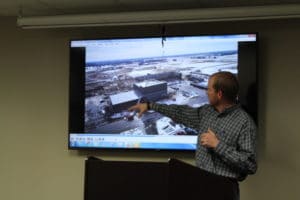by Dave DeMars
news@thenewsleaders.com
The Sartell-St. Stephen School Board had a full menu of items that occupied its attention at the regular Jan. 22 meeting. Those concerns included the progress of the new high school, fundraising for a new athletic complex and school calendars for 2018 through 2020.
Lee Gruen, project manager for the new high school, presented the board with a progress report. Eight working days have been lost in December and January because of cold weather setting exterior framing back about a week. Despite that Gruen was optimistic in his assessment of progress made on days that were able to be worked.
Precast walls in the theater area and the gym are complete with work starting on the pool as of Jan. 18. Roofing has started on the theater and the use of temporary heat sources has allowed for interior plumbing, electrical and heating work to progress. Much of the work is what is referred to as roughing in.
There is still a concern about the possibility of more cold weather, so the warm days of the past week were very welcome. The building has been divided into eight areas with different work proceeding in each area. Gruen said the entire building should be enclosed and roofed by June 21 of this year. That gives contractors about a year to complete the necessary interior and decorative exterior work. Presently about 50 to 60 workers are on the job. Once the building is enclosed and interior work begins in earnest, it’s expected there will be 150 to 200 workers.
The building is on budget and there have been no reported safety or security issues related to the project.
Athletic complex fundraising
Shawn Ogelsby, president of the Sartell Area Youth Soccer Association, and Kai Lewis, vice president of the Sartell Area Youth Football Association, made a presentation to the board on behalf of community fundraising for a community athletic complex they identified as a multi-sport stadium project.
It’s not just a stadium for football, but for many sports such as lacrosse, soccer and other sports as well, Lewis said. Part of the reason a stadium would be desirable is the increased number of players in these various sports. A stadium would include artificial turf.
Lewis and Ogelsby provided some rough cost estimates for the various aspects of the building project: $750,000 for artificial turf, $1.2 million for the stadium itself and $750,000 for the track.
Funds would be raised in the community and by partnering with local businesses. Among the possible funders mentioned were Coborn’s, DeZurik and K & A Autobody.
According to Lewis and Ogelsby, there is a need for improved facilities and this would provide a possible savings in the long run considering maintenance and upkeep costs of grass fields. Heavy use of grass fields often results in poor playing surfaces. Artificial surfaces last as long as 10 to 13 years with a minimal amount of maintenance.
Many of the surrounding communities – Sauk Centre, Monticello, Sauk Rapids, Alexandria, Buffalo and Brainerd – have invested in artificial-turf fields and in improved sports complexes. St. Cloud Tech and Apollo will probably be getting turf soon.
Several board members expressed concerns about funding the turf and complex.
“There has been considerable conversation about is turf necessary,” said Superintendent Jeff Schwiebert. “I would make the argument we should go with the grass-based field and the bleachers and the lights would help complement that.”
Board member Pam Raden expressed excitement over the possibility of the complex.
“One of the concerns I have is we asked the community for a really big gift to build the high school, and we may be asking for additional funds,” said board member Mary McCabe.
She went on to say it would not be a good idea to be in competition for the funds in the future.
“There is only a finite amount of money out there,” McCabe said. “I don’t want to put the board in the position of competing for dollars to finish up our (building) project. It’s important what we are doing in our project which is to build a school. We do have a phase two, and a phase three.”
She went on to say fundraising for the project was a laudable effort, but expressed the need for caution in approaching the community because of the number of projects going on.
Schwiebert cautioned the board’s attentive listening to the presentation should not be construed as approval or a willingness to commit to the idea of turf or the stadium.
School calendar
The board tackled the issue of the school calendar and immediately hit a stumbling block when board member Lesa Kramer proposed accepting the 2018-2019 calendar, but tabling the 2019-2020 calendar.
Schwiebert told the board the issues in making a calendar were the issues that always seem to plague the process even though a 20-member committee helped create it. Of concern was whether to have a spring break; when should spring break occur; if spring break were eliminated, should long weekends or something along that line be introduced in its place; and where to provide professional development days. Also in the mix was concern for accommodating spring and winter sports scheduling.
“I believe we have to approve the 2018-2019 calendar because we have established a pattern,” Schwiebert said. “People are already expecting this for the 2018-2019 year and I don’t think we can make any changes to that.”
Schwiebert went on to explain a major change is going to occur in 2020-2021 and referred to it as “the great change” when kindergarten through eighth grade will be changed throughout the district. Because of that change, Schwiebert thought that would be the ideal time to make changes to the 2019-2020 calendar.
“No matter what we do with the calendar, there will always be a sizable portion of your audience that doesn’t like what you have done,” Schwiebert said.
In the end, Kramer’s motion to approve the 2018-2019 calendar and table the 2019-2020 calendar passed with a 4-1 vote, with board member McCabe casting the no vote.
The approved 2018-2019 calendar provides for the start of school on Sept. 4, spring break from March 25-29, and the last day of school for students on May 31.
Other business
The board heard a brief presentation on the proposed decentralization of the media center in the new high school. Because of a shift in the philosophy of how to accommodate better learning, the idea of having more immediacy of access to books and media space is the driving force.
“We want kids to be able to grab books where and when they need to grab them,” Schwiebert said.
That means making access to books and media available throughout the building and in the various learning areas rather than in a centralized repository as was the case for many years. The open design of the new school also facilitates this idea.
“Learning should be visible,” Principal Brenda Steve said. “We will see what our kids are doing.”
Steve also provided the board with curriculum and program changes for 2018-2019. Five new courses will be implemented including two courses in the business area, a new advanced music theory class, a class in government and one in robotics technology.

This is the interior of what will eventually be the theater in the new high school. Even though the weather outside makes it impossible to do some parts of construction, enclosed areas such as this allow for continued progress to be made on the new school construction.

High school principal Brenda Steve explains how new philosophies about how students learn influenced the design of the new high school. Different learning areas require different types of classrooms.

Kai Lewis advocates for improved sports facilities during the Jan. 22 school board meeting. With the increased participation and emphasis at all ages on sports such as lacrosse as well as standbys like football and soccer, there is a need for more and better athletic fields, Lewis said.

Project manager Lee Gruen explains aspects of how the enclosing of some areas of the new high school have allowed for continuation of work even though recent cold weather slowed exterior work.



